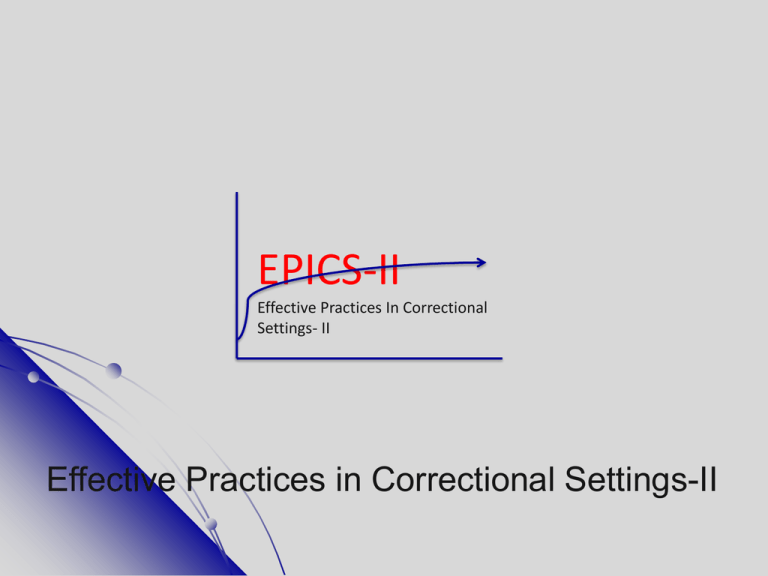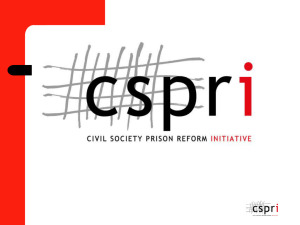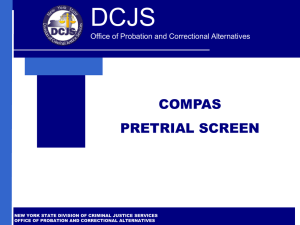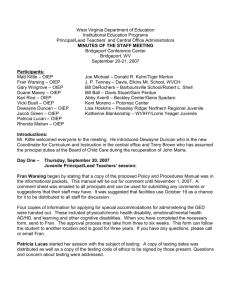Caseworker Training
advertisement

EPICS-II Effective Practices In Correctional Settings- II Effective Practices in Correctional Settings-II Introductions Melanie Lowenkamp Jen Kisela “When I read about the training I thought “I already do that”….when I went to the training I thought “I already do this”….when I got back and did it how I was trained I thought “I have been doing this”….it wasn’t until I got this incredibly different response from the offenders that I realized I had never done this before.” -Federal Probation Officer Anna Pakiela, Personal Communication 2009. EPICS-II Effective Practices In Correctional Settings-II Ohio Community Corrections Data EPICS-II Effective Practices In Correctional Settings-II What Do You Feel Responsible For? Inter Heart Study Risk factors for heart attack Identified 9 factors that predicted 90% of all heart attacks First 2 predicted 2/3rds Risk Factors For Heart Attack Cholesterol Current smoking Diabetes Hypertension Abdominal obesity Psychosocial Failure to eat vegetables and fruits daily Failure to exercise No alcohol consumption Comparison of HA & Crime Risk Factors Cholesterol Current smoking Diabetes • Attitudes • Peers • Personality Hypertension Abdominal obesity Psychosocial • Employment • Family • Substance abuse Failure to eat fruits & veg Failure to exercise No alcohol consumption • Housing, finances • Personal distress • Lower socio-economic status How Does What We Target & How We Target Make A Difference Plenty of current research indicating that when we incorporate core correctional practices we see reductions in recidivism Using core correctional practices ensures we are targeting relevant criminogenic needs & using a general model to change behavior Quality and nature of relationship • Skeem et al, 2007, Trotter, 1996 & 1999, Paparozzi & Gendreau, 2005, and others What we talk about • Andrews & Dowden, 1999 and others Moving beyond the check in • Taxman 2008 Core Correctional Practices • Bonta et al., 2008, Dowden & Andrews, 2004 The Balanced Approach Outcome Measures by Officer Orientation 70.0% 58.8% 60.0% 50.0% 42.5% 37.9% 40.0% Law Enforcement 32.3% Balanced 30.0% Social Work 19.0% 20.0% 16.2% 12.7% 10.0% 5.4% 6.3% 0.0% TV Revoked New Conviction Revocation Paparozi and Gendreau. An Intensive Supervision Program that Worked: Service Delivery, Professional Orientation, and Organizational Supportiveness. The Prison Journal, Vol. 85 No. 4, December 2005. Core Correctional Practices 40 35 30 25 20 15 10 5 0 34 31 30 30 28 27 25 16 11 11 12 10 10 10 9 11 Present Absent Dowden and Andrews, 2004 What to target How to target How well we do both • Behavioral Analysis • RACE • CHART-session structure • Bridging skills • Intervention skills • Fidelity of implementation • Peer coaching Relationship Skills Relationship Skills What type of relationship yields the highest benefit How to coach and mentor your clients & peers Important factors associated with effective correctional programs EPICS-II Effective Practices In Correctional Settings-II Relationship EPICS-II “a connection, association, or involvement” Professional and work related Friendly, but not friends Effective Practices In Correctional Settings-II Discussion Think about an effective coach you’ve had in your life (for sports, work, etc.) What qualities did that person have? What made him/her a good coach? EPICS-II Effective Practices In Correctional Settings-II Relationship Skills Spiegler and Guevremont note that the relationship “…is a necessary but not a sufficient condition of treatment.” Must also target criminogenic needs EPICS-II Effective Practices In Correctional Settings-II Relationship Skills Skills: 1. 2. 3. 4. 5. 6. Collaboration, autonomy, self-efficacy Empathy Active listening Giving feedback Role Clarification Structured skill building and graduated practice EPICS-II Effective Practices In Correctional Settings-II Role Clarification Key skill in working with involuntary clients Helps the client understand what to expect and what is expected of them Should be covered at the beginning of supervision EPICS-II Effective Practices In Correctional Settings-II Role Clarification Explain the supervision process Explain the various roles and responsibilities of a supervision officer •What are we (officer/offender) here for? •What are we hoping to get out of this? •What is required? •What can be negotiated? •Confidentiality of information EPICS-II Effective Practices In Correctional Settings-II Steps of Role Clarification 1. Identify the agency’s goals for the supervision process 2. Ask the client to identify what he hopes to accomplish during the supervision process 3. Identify what you, as a representative of the agency, hope to accomplish 4. Define the supervision process 5. Identify and discuss expectations of confidentiality What to target Behavioral Analysis RACE CHARTsession structure Risk Assessment Important for driving case planning, management, and risk reduction The results direct: Whom to target (high risk) What to target (criminogenic needs) EPICS-II Effective Practices In Correctional Settings-II Sample assessment scores Criminal History=MODERATE Substance Use= HIGH Education, Employment, and Financial situation=LOW Peer Associations= HIGH Family and social support=LOW Neighborhood Problems= LOW Criminal Attitude and behavior problems= MODERATE To be effective at reducing an offender’s risk we have to understand what puts them at risk. EPICS-II Effective Practices In Correctional Settings-II Behavioral Analysis “How do I know what to target?” Identifies high risk people, places, things, thoughts Uncovers specific targets for discussion Given as homework Used throughout supervision EPICS-II Effective Practices In Correctional Settings-II Behavioral Analysis Process where offender reports the offense chain for the last ten times he/she was in trouble or could have been in trouble Allows you and offender to look for patterns in behavior. These patterns tell us what to extinguish, identify situations to avoid, skills to develop, and what to reinforce This process makes supervision proactive instead of reactive! Behavioral Analysis When (day of week and time) Who were you What were you with Where were you? thinking/feeling (before/during)? (before/during)? What did you do? What were you thinking/feeling after? When (day of week and time) Weekday Afternoon Sunday morning Weekday morning Who were you with before/during? Where were you? Sample BA Guys at Community downtown service Andre Da’shon Self What were you thinking/feeling before/during? Prison I got time to stop by my house and see my grandma and get something to eat. What did you do? I shouldn’t have done that. Stopped by the house for That was stupid a few minutes I could’ve gotten then went caught back I’m gonna play this football I played it and ticket and make got caught some money with it afterwards My house I could get a good chunk of money for my mom’s TV What were you thinking/feeling after? That’s a petty rule It’s not about the ticket. Annoyed I need help. I took the TV to the pawn shop Guilt RACE Relapse prevention model used to help understand how to respond to their high risk people, places, things. EPICS-II Effective Practices In Correctional Settings-II Along with BA used early in supervision Implementing the steps of RACE will be an ongoing process Helps the client learn to make responsible choices RACE RECOGNIZE • High risk influencers that tempt the offender AVOID • By taking steps away from situations COPE • In situations where the high risk influencer cannot be avoided EVALUATE • Evaluate progress, make changes to the plan RACE Recognize Learn to recognize high-risk situations Avoid Cope Can you avoid? Plan If you cannot avoid, to avoid plan to manage Evaluate How can you better handle the scenario? What did you do well? RACE Audio example EPICS-II Effective Practices In Correctional Settings-II Avoidance Worksheet Can you realistically avoid this high risk person, place, thing, trigger (PPTT)? List all of the situations you might encounter this PPTT? If you avoid this situation what will you do instead? What specific steps will you take to avoid this situation What problems do you anticipate in avoiding this situation? What skills will you need to successfully implement the plan? After completing avoidance worksheet proceed to coping-contingency plan Avoidance Worksheet - R=Stress Can you realistically avoid this high risk person, place, thing, trigger (PPTT)? List all of the situations you might encounter this PPTT? If you avoid this situation what will you do instead? What specific steps will you take to avoid this situation What problems do you anticipate in avoiding this situation? What skills will you need to successfully implement the plan? Conflict with girlfriend (screaming at each other) Separate from each other when tension is present. Talk to her when we are both calm. Difficulty learning a new way to communicate. Communication skills Going back to old habits. Time out technique Calmly discuss issue. Create a plan that we both agree on. 3 Step Coping Worksheet-contingency Complete the following worksheet to be used in situations where unforeseen high-risk situations occur List some potential situations where the avoidance plan may fail: What specific steps will you take to remove yourself with minimal risk of relapse or other problems What potential problems can you anticipate by implementing your plan? How will you handle these problems? What skills will you need to successfully implement the plan? Coping Worksheet-primary plan Complete the following worksheet to be used in situations where the high risk PPTT CANNOT be avoided. When encountering this high risk PPTT my risk reaction is:_________________ List specific circumstances surrounding this PPTT that increase the likelihood of triggering your risk reaction What specific steps will you take to effectively cope with these circumstances What potential problems can you anticipate by implementing your plan How will you handle these problems What skills will you need to successfully implement the plan Coping Worksheet-primary plan Complete the following worksheet to be used in situations where the high risk PPTT CANNOT be avoided. When encountering this high risk PPTT my risk reaction is: Anger/ Violence List specific circumstances surrounding this PPTT that increase the likelihood of triggering your risk reaction What specific steps will you take to effectively cope with these circumstances What potential problems can you anticipate by implementing your plan How will you handle these problems What skills will you need to successfully implement the plan She starts accusing me of being with other women Explain to her that I don’t want to argue Tell her we need to separate until we are both calm. Leave the She’ll continue to scream at me. She won’t let me leave. She’ll start hitting and kicking me. Take a deep breath Don’t raise my voice. Explain that I will call her in an hour. 3-step Skill step “responding to anger” Skill step “responding to an accusation” Structure of an interaction Purposeful and Intentional Focuses on addressing and changing target behaviors •Be prepared for meeting EPICS-II Effective Practices In Correctional Settings-II Questions to ask yourself C • Check-in H • Homework A • Assess & Apply R • Reinforce T • Teach Session 2- How to target Bridging Skills Intervention Skills Structured Skill building Bridging Skills EPICS-II Effective Practices In Correctional Settings-II Bridging Skills Serve as a “bridge” between relationship and behavioral change Development and maintenance of a relationship Basis of behavioral change EPICS-II Effective Practices In Correctional Settings-II Bridging Skills Changing offender behavior Effective Use of Authority Effective Use of disapproval Effective use of Reinforcement Changing Offender Behavior Punishment and Reinforcement Building blocks of operant conditioning Behavior is developed and maintained through a series of consequences Punishment stops a behavior/ Reinforcement strengthens and teaches a new behavior EPICS-II Effective Practices In Correctional Settings-II Effective use of reinforcement EPICS-II Effective Practices In Correctional Settings-II Reinforcement Positive reinforcement Negative reinforcement Involves the application of a stimulus to increase behavior. Involves the removal of a stimulus to increase behavior. Example: A client reports getting a job and receives verbal praise. Example: A halfway house client has clean U.A.s for an entire month and is taken off restriction Types of Reinforcers Social reinforcers • Praise, acknowledgement, attention, approval, etc. • Advantages: ease of administration, limitless supply, can use immediately, naturally reinforcing Reinforcing activities • Watching television, playing sports, listening to music, playing computer games, and talking on the telephone Token items and material objects • Certificates, bus tokens, food, etc. • Hard to do in criminal justice system Skill Steps for Effective Reinforcement Tell the client what she did that you like and why it is important Ask the client, in her own words and thoughts, what are the short and long term benefits of continuing to use the behavior Contract with the client to use the skill/behavior, you are discussing, again in the future Audio Demonstration Effective use of punishment and disapproval EPICS-II Effective Practices In Correctional Settings-II Punishment (Positive) punishment (Negative) punishment Involves the application of a stimulus to decrease behavior. Involves the removal of a stimulus to decrease behavior. Example: An offender submits a positive drug screen and is required to report weekly. Example: An offender fails to report and has the privilege of picking report day and time removed. Skill Steps for Effective Disapproval Identify the inappropriate behavior and tell the client, in an objective manner, that you disapprove of what was said or done. Ask the client to explore the short-and long-term consequences of continuing to engage in that behavior. Ask the client to identify and discuss pro-social alternatives that could be used in place of the unacceptable behavior. Contract with the client to use the pro-social alternative in the future. Effective use of disapproval IF YOU ARE ADMINISTERING A PUNISHMENT FOLLOW STEPS 5 & 6 Tell the client what the consequence will be • “Because you chose to ____, then your consequence will be ______” Deliver the consequence Audio Demonstration Effective use of Authority EPICS-II Effective Practices In Correctional Settings-II Effective use of Authority Using authority in an effective manner Nature of our jobs: getting people to do what they don’t want to do Gives the client control in making decisions Firm, but fair approach Skills steps for effective use of authority Identify a situation where the client is in a decision-making position Present the available choices and the attendant consequences • DO NOT USE DOOMSDAY ULTIMATUMS At the next available opportunity, follow-up by determining if objectives were met (which choice did they make?) Reward or praise compliance (if applicable) Intervention Skills EPICS-II Effective Practices In Correctional Settings-II Intervention Skills 1. 2. 3. 4. Cognitive Model Applying and reviewing the cognitive model Problem-solving skills Time out EPICS-II Effective Practices In Correctional Settings-II Cognitive Model Cognitive-Behavioral Therapy (CBT) Evidence based treatment Yields the strongest, most consistent benefit in reducing recidivism Emphasizes the important role that thoughts and feelings have in determining behavior The Cognitive Model: A pictorial representation of external events, thoughts, and the resulting behavior. EPICS-II Effective Practices In Correctional Settings-II Cognitive Behavioral Therapy Everyone has thoughts before acting, we just aren’t always tuned into them 63 Cognitive Model Benefits of teaching the Cognitive Model Increases awareness of high risk thoughts that typically lead to trouble Helps the client see and understand the connection between thinking and behavior Starts the process of restructuring antisocial thoughts and replacing them with alternative, prosocial thoughts The Cognitive Model EXTERNAL INTERNAL BEHAVIOR “Thinking Controls Behavior” Cognitive Model worksheet EXTERNAL INTERNAL THOUGHTS BEHAVIOR CONSEQUENCES REPLACEMENT THOUGHTS NEW BEHAVIOR CONSEQUENCES Sample worksheet EXTERNAL Friends that I used with in the past called me to see if I wanted to go out with them INTERNAL THOUGHTS This could be a lot of fun. I have been working hard. I deserve a break. I won’t use I’ll just watch and laugh. I might meet a guy. REPLACEMENT THOUGHTS I will feel like hell tomorrow. I will feel guilty. I will worry about having to drop. I could get arrested. I might use. I might meet a guy but he’ll be a loser. I could go back to prison. BEHAVIOR Go hang Might use. out. NEW BEHAVIOR Told friends I can’t do that anymore. Stayed at home with my son. Felt a big relief after I hung up phone. CONSEQUENCES Get arrested. Test positive. Get revoked. CONSEQUENCES Felt proud and like “I can make it”. Spent time with son. Stayed out of trouble Why does training fail? EPICS-II Effective Practices In Correctional Settings-II Integrating Training into the Workplace Joyce and Showers (2002): Training consisting of.. Theory and + Discussion Demonstration + Practice and and Modeling Feedback Resulted in… Only 5% of teachers using the skills Joyce and Showers (2002) Theory and Discussion Demonstration + and Modeling + Practice and Feedback + On-the-job training Resulted in… 95% of teachers used the skills Integrating New Training in the Workplace Rogers (2002) “only about 10% of what is taught in training is transferred to the job” Training alone is not sufficient to ensure fidelity Why is it so difficult to adopt a new skill? 2 main reasons: 1. The training was inadequate. 2. Failure in the transfer of learning back to the workplace. Why? Newly learned behavior is fragile and needs to be supported in the face of reactions from clients Initial reaction may be positive or negative Negative reactions may cause the behavior to desist Stress or discomfort may cause the behavior to desist Difficult to extinguish old habits Perception that new behavior will be too time consuming or difficult to master Organizational characteristics do not support new behavior EPICS-II Assists in building the infrastructure to support implementation Provides the keys for effective implementation Training for “peer coaches” Support staff through early stages of implementation until new behavior is embedded Prepare staff for potential reactions Work one on one with staff with master the skills Direct observation & providing feedback Keys to Effective Implementation Start small, train staff Ensure program integrity through consistent coaching and careful monitoring Tape interactions As supports are in place continue to train staff Pick one target and target it well! Closing & Questions 1. 2. 3. 4. 5. Assessment, Relapse Prevention and Session Structure Relationship & Coaching Skills Bridging Skills Intervention Skills Fidelity of Implementation EPICS-II Effective Practices In Correctional Settings-II








